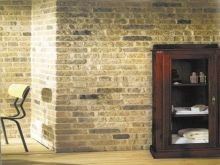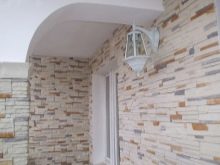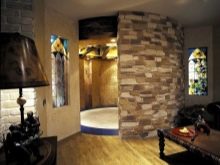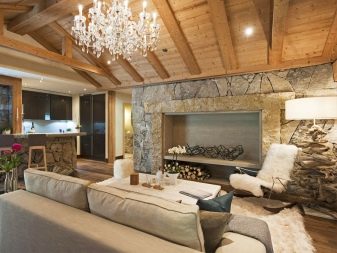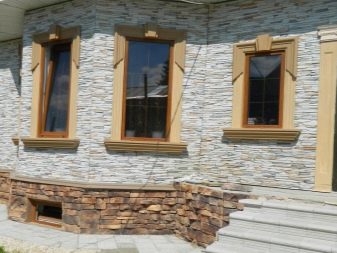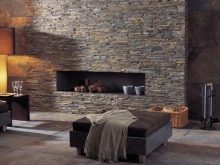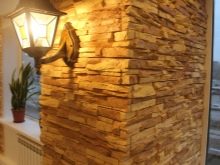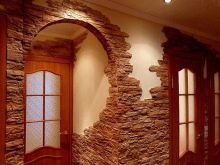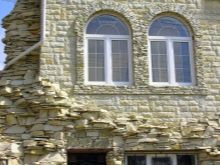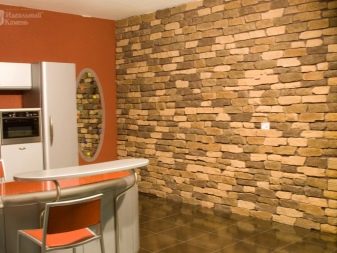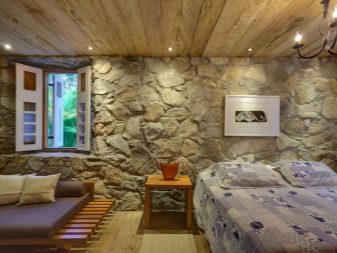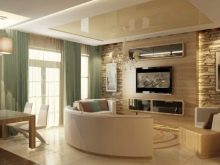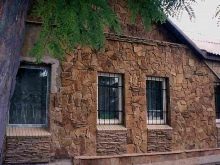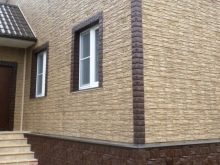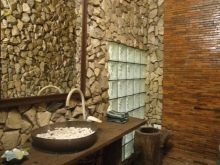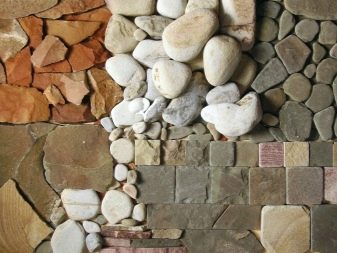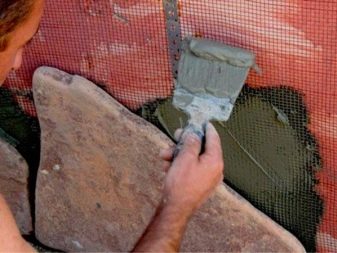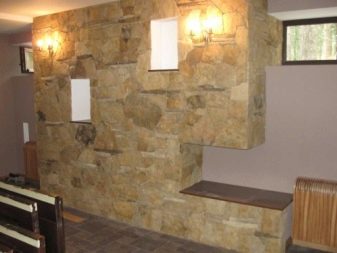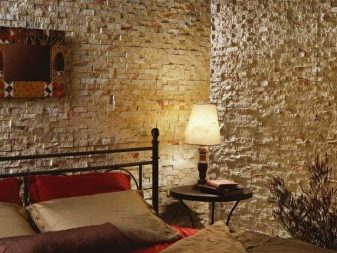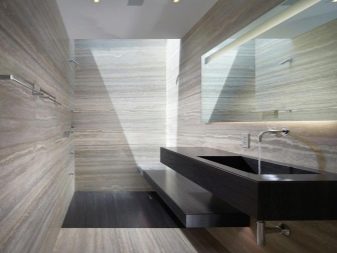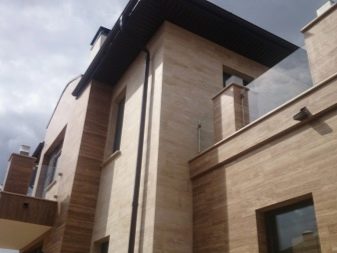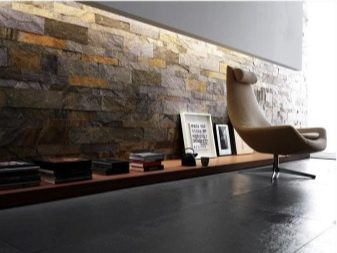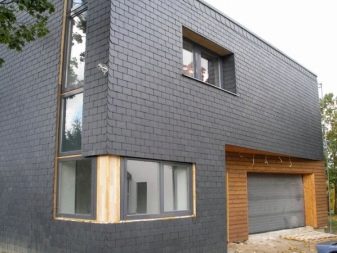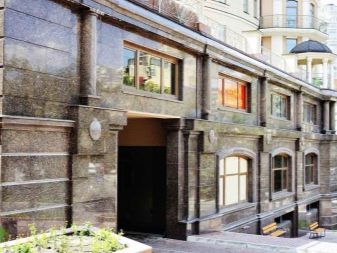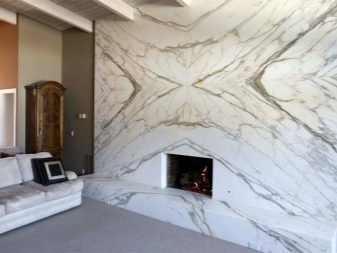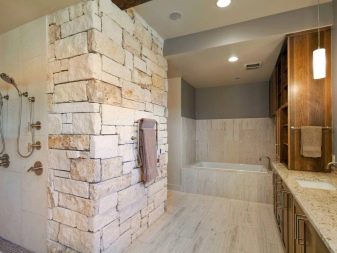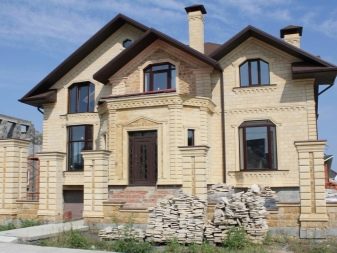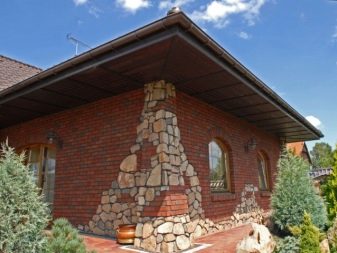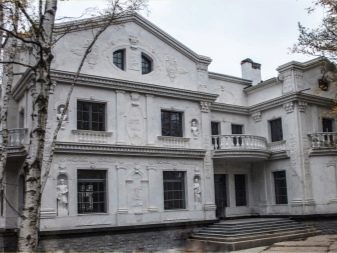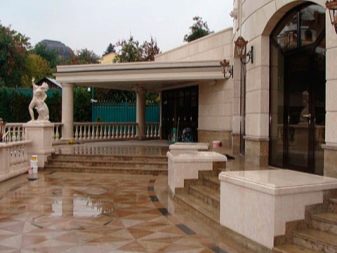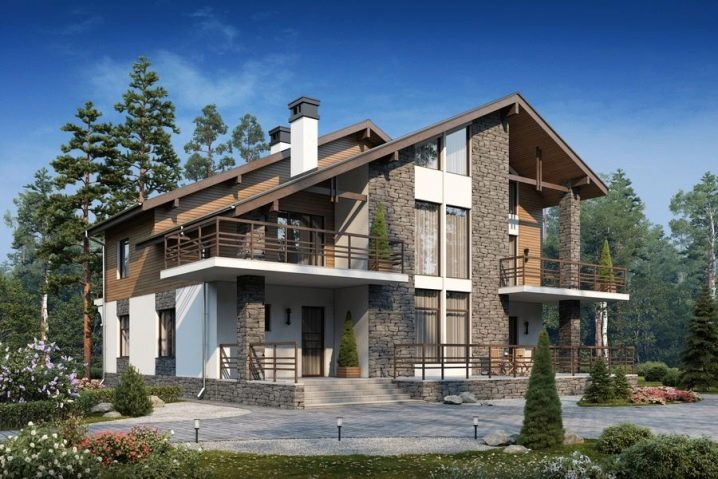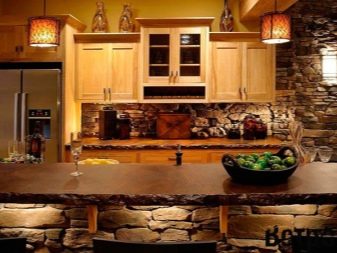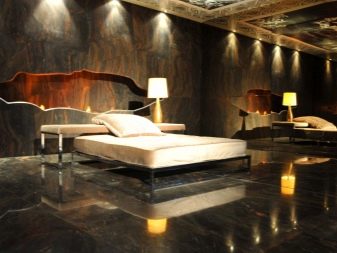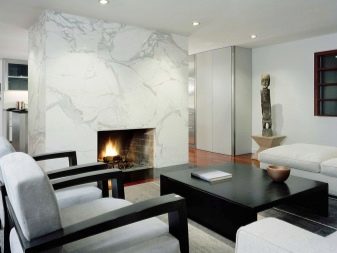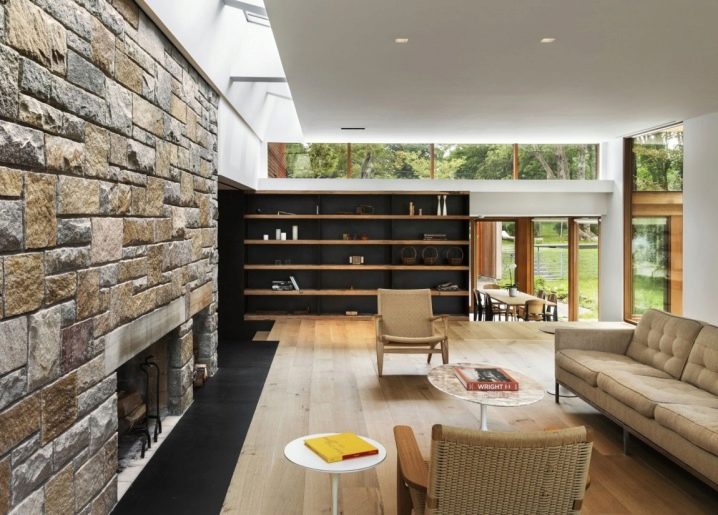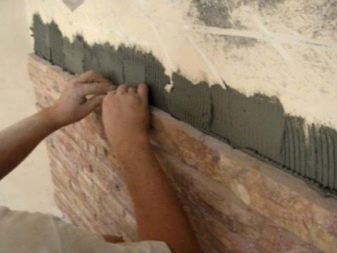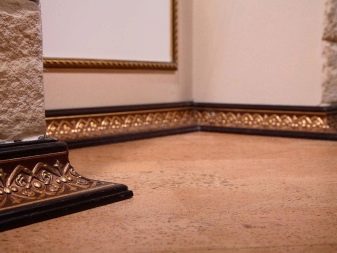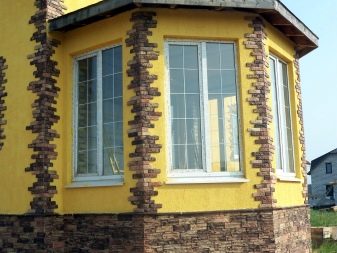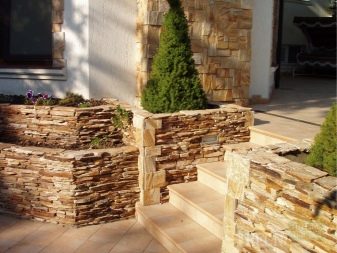Use of facing stone for wall decoration

Natural stone can be suitable for fashionable interior design and exterior of the house, if you want to revet the walls, you can choose the most diverse options for colors and textures. In addition, such stylish decoration of living space can be done even with your own hands. From this article you will learn how to successfully choose a natural stone and make a beautiful lining.
Special features
The facing stone is a traditional covering for facades of houses, but it is quite often used also in an interior. This is a beautiful natural material.which effectively emphasizes almost any design. However, for the application of the stone you need to study a number of features of such a coating.
First of all, you need to carefully examine the GOST before planning the laying of a natural facing material.: it is very heavy, therefore it is impossible to treat such a decoration lightly. It may be necessary to strengthen the foundation of the house or additional wall reinforcement. Often, the necessary reinforcement is difficult to implement, if the house is already built, it forces some to abandon natural stone cladding in favor of lighter options: plastic or wood.
Natural stone slabs can have very different shapes and sizes: in production, the stone is cut on special machines that allow you to create flat and flat slabs for easy installation.
Depending on the design decision, you can choose the options of a certain shape and size, or combine different stones to achieve the effect of deliberate negligence. Moreover, the thinner the plate of natural stone, the less will be the weight of the structure.
It is necessary to pay attention to the color of the stone slab: natural material pleases with a large variety of pleasant natural shades. You can find gray, black, terracotta, beige, pink or whitish options. All this can be interesting to combine with each other, to become a self-sufficient part of the interior design or exterior of your home. Some stones on the cut have an unusual pattern, resulting from the mixture and the layering of rocks - these options will look especially unusual, but working with them will be more expensive.
Finally, it is important to pay attention to the features of the texture. Natural stone can be porous, rough, have various inclusions or be homogeneous.
Some slabs for cladding grind to a glossy shine of the stone, but the options with a perfectly smooth texture are more expensive and do not always look organic, especially when finishing the facade.
Advantages and disadvantages
Today, many synthetic versions of finishing materials have been created, which are distinguished by their beautiful appearance, low cost and ease of installation.However, many still choose natural finishing stone for decorating their living space.
It looks beautiful and is completely eco-friendly, with such veneer you can feel yourself closer to nature.
At the same time the facing stone has a number of advantages and disadvantages that must be considered when choosing.
Since the stone remains a popular product for finishing work, despite the high price and difficulty in working, It is worth starting with the advantages of this natural material..
- First of all, natural stone is very durable. If a wooden or plastic finish in several years requires restoration and then replacement, the masonry will remain in its original form for decades.
- Natural natural stone, unlike synthetic acrylic casting, is resistant to thermal, atmospheric and mechanical stress. You can successfully decorate with this material not only the inner walls of the rooms in your house, but also the exterior.
- Frost resistance is a separate quality of natural material, especially relevant for most regions of Russia and the CIS countries.
- Environmentally friendly material also matters. Often in a country house you want to use the most natural materials to create a special atmosphere and a sense of unity with the outside world. The stone will perfectly fit into such a concept.
- Natural stone - fireproof. If a fire breaks out near your house, a stone-trimmed house will be protected from fire.
- Natural material is heat resistant. Even if there is a hot summer in your region, you may be able to do without air conditioning: unlike synthetic materials that easily conduct heat, natural stone will allow you to maintain an optimal temperature inside the house.
- Stone slabs are waterproof, which can also be a useful quality for both exterior and interior decoration.
- A wide variety of textures, colors and textures will allow you to choose the perfect option for any design project. In addition, you can combine two or three types of stone for an even more unusual decor.
It should be noted, and the obvious disadvantages of this material.
- The large weight of natural stone creates a lot of difficulties during its transportation, planning of masonry and direct installation.
- It is necessary to make preliminary calculations to ensure that the foundation and walls can withstand the weight of the masonry.
- Installation will be time consuming for a combination of reasons: it is a large weight of stone slabs, and the need to lay out small fragments individually, and the difficulty in cutting the stone when you need to carefully arrange the joints. For these reasons, self-installation causes a number of difficulties, and the work of professionals is quite expensive.
- The stone itself also has a high cost, incomparable with wood or synthetic materials of decoration.
Species
Masonry wall cladding may have different appearance and slightly different properties. Before planning to finish the exterior or interior walls, the most important thing is to decide on the type of material you want to use.
Consider the following options.
- Sandstone - This is a fairly common stone for the facade of the house, but sometimes it is successfully used for interior work. Sandstone is a sedimentary rock with a high content of quartz. It is rough in its texture and torn on the chips,while the color range is limited to a gray-beige palette, nevertheless it is a very durable and inexpensive stone, and the low-key color will allow the house to merge with the landscape.
- Limestone - another inexpensive and common stone. Most often it has whitish and yellowish shades, although, depending on the impurities, there are interesting variations of limestone, it can even be black. This option has a porous structure and low density, however, among the advantages, it is worth noting the minimum weight of such a stone. One of the most popular types of limestone is the shell rock: it is usually a crushed stone of white or gray color, in which fragments of mollusk shells are visible. Such an unusual solution may look interesting both on the facade and in the interior.
- Dolomite - a stylish, interesting stone, which can have a wide color palette: from whitish and gray shades to yellow, beige, pink or terracotta tones. The stone is porous, dense and rough or similar to marble. Nevertheless, all these variants of dolomite are quite close both in their industrial characteristics and in their visual properties.Facing such a stone often resembles a ceramic surface: it is a more or less smooth texture with barely noticeable tints of color. A rubble stone can look stylish - these are fragments of various sizes with jagged edges.
- TravertineAlso called tuff is an intermediate between limestone and marble. The stone is fairly light, but dense, which allows it to be used in the form of very thin slabs. The Ural travertine is most often sold, it has a predominantly black color with beautiful whitish streaks, but other interesting color palettes are also possible. The stone can be easily polished to a perfectly glossy surface and is a cheaper equivalent of marble. This option is great for walls and outside, and inside the house.
- Caucasian slate It is widely used for cladding facades of private houses. Most often it is matte, which is an indicator of high silicon content. Nevertheless, there are more rare options that will have a smooth surface and shine. As for the color palette, the slate is limited to a dark tonal scale.These are usually black or dark gray stones, and occasionally dark brown and terracotta are possible.
- Granite - Another popular stone, which is used by plates of various shapes and sizes, mainly for the external cladding of buildings. The unusual gray-pink color with streaks and splashes makes this stone an extremely interesting material for exterior design. With all the originality, the gray stone will not stand out excessively on the site, it can be perfectly combined with other materials in the decoration of the facade.
- Marble - This is a noble stone, which is also often used for cladding the facade of the house, and for interior decoration. The material is quite expensive, it is not easy to work with it, however, as a result you will get an impeccable shiny surface, and the beauty will remain for many years. White, pink or gray marble is most often used, but its color range is very diverse, it all depends on the impurities that make up it.
Today, there is also a wide variety of options for artificial stone, it is much more practical when finishing, as it has less weight and thinner plates.In addition, the colors and texture of such a stone can be almost any, and the price will not be too high.
The artificial stone will help you easily and budgetary to realize any design idea. However, the material will not be as heat-consuming and durable as natural options.
Application
Natural stone slabs are very often and successfully used both in the decoration of the facade, and in interior design. At the same time the laying from a stone can actually look in the most various styles.
If you yourself decide to consider a design project for the exterior or interior of the house, it is worthwhile to decide on the choice of stone.
For outdoor use
It is for the facade that masonry is used most often, it allows you to beautifully decorate a wall of concrete. For a wooden house, laying stone will not work: the walls are not strong enough. However, you can decorate a concrete house with both wood and natural stone at the same time.
Consider the following most fashionable and relevant options.
- If you have planned a house in Russian style, sandstone or shell rock will suit you: light gray and beige options will allow you to create a beautiful facade of a house with a discreet design.If you wish, you can complement the decoration with carved elements of dark or light wood, as well as decorate individual parts with bright ceramic tiles. If, on the whole, you want a more striking facade, you should consider artificial material in a red-brown gamut.
- For home in classical or neoclassical style worth considering marble. It is best to choose a natural option, however, if the budget does not allow, you can also consider casting analogue of marble, which apparently is not too different from the present. For this style is characterized by mostly light finish. Consider a pure white shade or interesting patterns with blotches and colored stains; these details can make your home special.
- For home Scandinavian style dark gray shades of stone are perfect, you can consider both natural and artificial options. The best will look stone slabs of irregular shape, it will create the effect of deliberate negligence and antiquity. However, if you like more modern aesthetics, you can find a stone in the form of narrow bricks, which will also look good.
In the interior
You can use the masonry and to finish the walls of the rooms inside your house. The stone is perfectly combined with any wallpaper, wooden clapboard or the usual painting of the walls. Brick or stone is rarely used for interior decoration of the entire interior, such masonry may look too catchy. ABOUTStone is usually only one of the accents in the interior.
- Very often all kinds of stone are used. country style. This design decision is especially characteristic for houses with wooden furnish inside. In such an interior can look great beige and terracotta stone. If you want to play on the contrast of shades, you can pick up gray and whitish tones under the wood: this solution will allow you to additionally highlight the masonry. For a living room, dining room, loggia or hallway, a combination of wood and stone will suit perfectly.
- In modern style It is customary to combine unexpected contrasting tones. For example, in the decoration may look great combination of black and white marble. For a small room, it is better to make a light base with small dark decorative elements, and if the space is large,then you can arrange it mainly in a dark tone or combine colors in equal proportions.
- If you want to decorate the interior in modern style, dolomite with its unusual texture and wide range of colors will suit you. If the rest of the house is quite restrained, you can combine different colors of the stone and even make a mosaic of them. In this case, the stone will be perfectly combined with any textiles, wallpaper, varnished wood, metal and ceramics.
Useful tips
The choice of stone for finishing is very important. If you have conceived a similar design of the exterior or interior of your home, but do not know where to start, note the design tips from designers.
- Before acquiring the desired stone and installing it, it is very important to perform the calculations: for this you will need the detailed characteristics of the foundation, the parameters of the walls, their thickness and density. All these data you need to take from the developer, if you have planned to finish the stone. If you are not sure whether the walls will withstand your finish, you can order a calculation from the professionals.
- Putting natural material with your own hands is only if you have the basic knowledge and skills in such a matter.If not, it is better to turn to professionals or choose an artificial stone for self-assembly: it is much easier to work with it, you can simply glue some options with a special solution.
- When working with natural stone, the finishing of corners is particularly difficult: you need to accurately calculate the amount of stone to fit it. If you do the finishing yourself, take care of cutting the stones to the desired size.
- When finishing the interior, special attention should be paid to joints with the floor. Regardless of whether you have a laminate, linoleum or parquet flooring, it is best to place a plinth around the perimeter. If you think that it does not fit into the design, it is important to arrange the joints very carefully, correctly cutting the stone and sticking it carefully, putting the lining on top of the floor covering at the junction so that there are no gaps.
The best options
There are many options for the decor of the facade and interior with stone. If you can not decide on the design, consider ready-made ideas. Perhaps successful design projects will inspire you on your own.
- When decorating the facade of the house does not necessarily cover the whole house with stone. The laying can be interesting to look and with other decor, for example, usual coloring. Please note that the stone should stand out against the general background, but not be too contrasting. Usually choose masonry darker than the main color of the house.
- Natural material can allow you to seamlessly fit your home into the surrounding landscape. To emphasize closeness to nature and harmony with it, try to stone not only the walls of the house, but also nearby elements - stairs, paths, fountains or flower beds. This will help you to unite the whole section into a single ensemble.
- The interior masonry always looks unusual, but to highlight it, do not necessarily choose the bright color of the stone. On quite restrained brown, beige and gray versions can be emphasized through proper lighting. LED wall lights are now in vogue; they will help not only to create a pleasant soft light in the room, but also to highlight the unusual texture of the masonry.
- If you decide to stone not just one wall in the room, but a wider area, you should not choose solid material, such facing often looks very boring.At the same time, contrasting options are also best avoided so that the interior is not variegated. The ideal solution is to take several colors that are close in color but different in tone. For this purpose, for example, the beige color scale will be perfect: you can combine cream, ocher and brown shades.
How to carry out facing of walls a stone, look in the following video.
